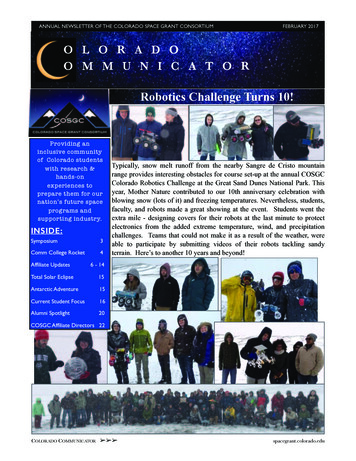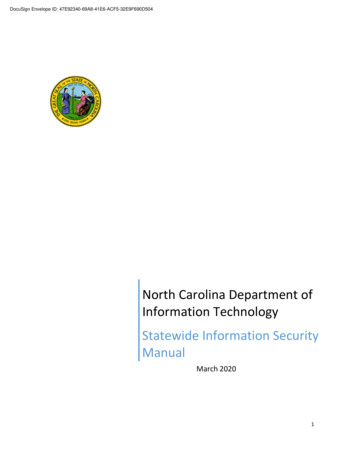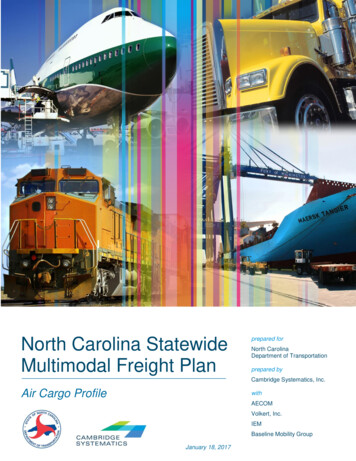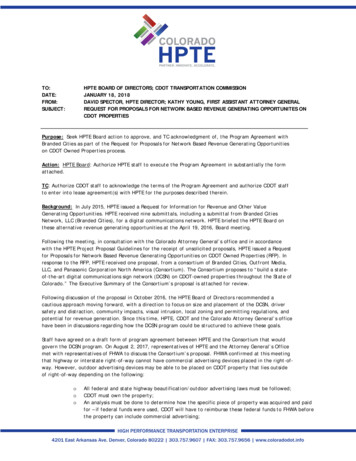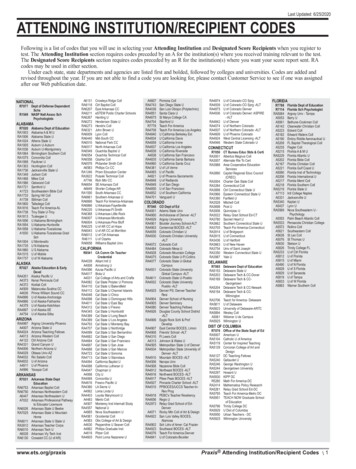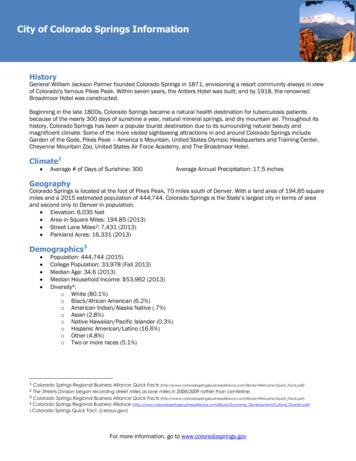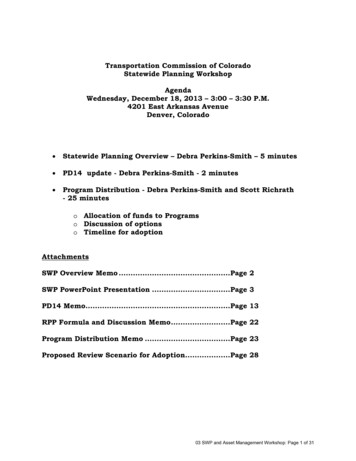
Transcription
Transportation Commission of ColoradoStatewide Planning WorkshopAgendaWednesday, December 18, 2013 – 3:00 – 3:30 P.M.4201 East Arkansas AvenueDenver, Colorado Statewide Planning Overview – Debra Perkins-Smith – 5 minutes PD14 update - Debra Perkins-Smith - 2 minutes Program Distribution - Debra Perkins-Smith and Scott Richrath- 25 minuteso Allocation of funds to Programso Discussion of optionso Timeline for adoptionAttachmentsSWP Overview Memo .Page 2SWP PowerPoint Presentation .Page 3PD14 Memo.Page 13RPP Formula and Discussion Memo .Page 22Program Distribution Memo .Page 23Proposed Review Scenario for Adoption.Page 2803 SWP and Asset Management Workshop: Page 1 of 31
MEMORANDUMDEPARTMENT OF TRANSPORTATIONDivision of Transportation Development4201 East Arkansas AvenueDenver, Colorado 80222(303) 757-9011DATE:December 5, 2013TO:Transportation CommissionFROM:Debra Perkins-Smith, Director, Division of Transportation DevelopmentSUBJECT:Statewide Planning OverviewPurpose:Attached are slides that provide a brief overview of the state and federal requirements forstatewide planning and some highlights of the CDOT Statewide Plan now under development.The early steps in Plan development include the adoption of the Planning Rules (adopted inOctober, 2012), the projection of revenues for the planning horizon (2016-2040-adopted April,2013), the establishment of performance goals and objectives (PD 14), and the allocation offunds to programs needed to support those objectives (Program Distribution).As illustrated in the graphic below, the Transportation Commission sets policy, revenueprojections, and program distribution to guide the development of regional plans that identifycorridor based strategies for transportation improvements. Those regional plans are thenintegrated and consolidated into a statewide transportation plan. The plan serves to guide theselection of projects that contribute to the achievement of adopted objectives and that areincluded in the Statewide Transportation Improvement Program (STIP).Action Required: None. Information Only.03 SWP and Asset Management Workshop: Page 2 of 31
Statewide Planning OverviewDebra Perkins-SmithDecember 18, 201303 SWP and Asset Management Workshop: Page 3 of 31
Statewide Planning Based in State law and Federal Regulations Update cycle every four years for areas inAQ non-attainment areas Work with MPOs and TPRs to get updateson same or similar schedule MPOs develop their own plans per Federalregulations and with Planning funds CDOT staff supports TPRs in development oftheir plans03 SWP and Asset Management Workshop: Page 4 of 31
State Legislation CRS 43-1-1103. Transportation Planning Integrate and consolidate regional plansinto a comprehensive statewide plan Identify facilities and services needed to meetestimated demand over a 20 year period Identify what can be reasonably expected tobe implemented with estimated revenues03 SWP and Asset Management Workshop: Page 5 of 31
State Legislation Statewide Transportation Plan shall address: Multimodal (transit/bike/ped)System PreservationMobilitySafetyFreightEnvironmental StewardshipGreenhouse gas reduction03 SWP and Asset Management Workshop: Page 6 of 31
Federal Regulations State shall develop long range plan with aminimum 20 year forecast period Provide for performance based approach todecision making Include description of performance measuresand targets used to assess system performance Plan shall be developed in cooperation withMPOs, Tribal governments andnon-metropolitan local officials03 SWP and Asset Management Workshop: Page 7 of 31
Federal Regulations Include capital, operations and managementstrategies to ensure preservation and efficientuse of the existing system Include environmental considerations May include financial plan with reasonablyexpected resources03 SWP and Asset Management Workshop: Page 8 of 31
Federal Regulations Statewide Plan will address factors: Economic vitality Safety and security for motorized andnon-motorized travelers Mobility of people and freight Environment Multimodal connectivity Efficient systems operations Preservation of system03 SWP and Asset Management Workshop: Page 9 of 31
CDOT’s Statewide Plan Establishes a transportation vision for the State Addresses state and federal regulations Identifies short-term (10 year) and long-term (25 year) needs for amultimodal transportation system Includes performance measures and targets to assess systemperformance Includes stakeholder involvement Provides strategic direction and allocates resources to programsto achieve goals (Policy Directive 14) Integrates all CDOT modal plans, risk-based asset managementplan, and other CDOT initiatives Integrates MPO and TPR Regional Transportation Plans Final product will be web-based Enables progress reporting post adoption03 SWP and Asset Management Workshop: Page 10 of 31
CDOT’s Statewide Plan The Statewide Transportation Plan guidesinvestment for a multimodal, comprehensive systemthat balances preservation and maintenance,efficient system operations and managementprocess, and capacity improvement whileincorporating risk-based asset management andbest business practices.03 SWP and Asset Management Workshop: Page 11 of 31
CDOT’s Statewide Plan03 SWP and Asset Management Workshop: Page 12 of 31
MEMORANDUMDEPARTMENT OF TRANSPORTATION4201 East Arkansas AvenueDenver, Colorado 80222(303) 757-9011DATE:December 6, 2013TO:Statewide Plan Committee of the Transportation CommissionFROM:Debra Perkins-Smith, Director, Division of Transportation DevelopmentSUBJECT:Policy Directive 14PurposeAttached is the updated version of Policy Directive (PD) 14, which now includes the aspirational objectivesreviewed at the November Transportation Commission Workshop, as well as clarification for some objectives ontimeline.Action RequestedReview and comment on PD 14 as it guides Program Distribution for the Plan.Additional Information Related to PD 14 The linkage between PD 14 and Program Distribution – MAP-21 (Moving Ahead for Progress in the 21stCentury Act), states that performance measures and targets (objectives) shall be considered whendeveloping policies, programs, and investment priorities that are reflected in the StatewideTransportation Plan (SWP) and Statewide Transportation Improvement Program (STIP). CDOT’sperformance measures and objectives are stated in Policy Directive (PD) 14. One of the primarypurposes of PD 14 is to direct the distribution of financial resources toward accomplishing the objectiveswhen developing the SWP, the STIP, and the annual budget. MAP-21 Rulemaking – Rulemaking for MAP-21 is in progress with Notices of Proposed Rulemakingexpected in spring and summer of 2014. The rules for MAP-21 are anticipated to become effective inspring 2015. Thus, some modification to PD 14 based on MAP-21 rules may be required in the future. Public Involvement – with Plan development include on-going input from stakeholders and finalize PD 14with Plan adoptionNext StepAdoption of Program Distribution based on draft PD 14 objectives.03 SWP and Asset Management Workshop: Page 13 of 31
POLICY DIRECTIVEPROCEDURAL DIRECTIVECOLORADO DEPARTMENT OFTRANSPORTATIONSubjectPolicy Guiding Statewide Plan nating OfficeDivision of Transportation Development &Office of Financial Management and BudgetI. PURPOSEThis Policy Directive provides an overall framework for the transportation planning processthrough which a multimodal, comprehensive Statewide Transportation Plan will be developedthat optimizes the transportation system by balancing preservation and maintenance, efficientoperations and management practices, and capacity improvements. Policy Directive 14.0performance objectives will direct distribution of resources for the Statewide TransportationPlan, the Statewide Transportation Improvement Program, and the annual budget. This PolicyDirective is in alignment with the national goals in the 2012 federal transportation authorizationlaw, MAP-21 (Moving Ahead for Progress in the 21st Century Act). This Policy Directivereflects CDOT’s risk based asset management program and plan that incorporates a businessapproach intended to optimize investment for maintenance and preservation of CDOT assetsbased on both risk and performance assessment.II. AUTHORITY23 United States Code (U.S.C.) 134, 135 and 450, PL 112-141 (“Moving Ahead for Progress inthe 21st Century” or “MAP-21), and its implementing regulations.§ 43-1-106(8)(a), Colorado Revised Statutes (C.R.S.) Transportation Commission§ 43-1-1103, C.R.S. Transportation planningTransportation Commission Rules Governing the Statewide Transportation Planning Process andTransportation Planning Regions (2 CCR 601-22)III. APPLICABILITYThis Policy Directive applies to all CDOT Divisions and Regions involved in implementing theStatewide Transportation Plan in cooperation with CDOT’s planning partners: the 10 ruralTransportation Planning Regions and the five Metropolitan Planning Organizations.IV. DEFINITIONS“Aspirational Objectives” are those objectives, or targets, toward which CDOT may striveshould CDOT receive revenues beyond those projected.Page 1 of 803 SWP and Asset Management Workshop: Page 14 of 31
SubjectNumberPolicy Guiding Statewide Plan Development14.0“Drivability Life” is an indication in years of how long a highway will have acceptable drivingconditions based on an assessment of smoothness, pavement distress, and safety. DrivabilityLife implements traffic based highway categories, and associated category drivabilitycondition standards and allowed pavement treatments. Unacceptable driving condition isspecific to each traffic based highway category and means drivers must reduce speeds tocompensate for unsafe factors, navigate around damaged pavement, or endure intolerablyrough rides.“National Highway System” (NHS) is a federally designated system of roadways important tothe nation's economy, defense, and mobility. The NHS includes Interstate highways as well asother roadways. Not all NHS roadways are part of the state highway system.“Maintenance Level of Service” (MLOS) is a qualitative measure describing operationalconditions on the roadway. Overall maintenance level of service is a combined grade for ninemaintenance program areas. For snow and ice control, the LOS B level includes maintaininghigh levels of mobility as much as possible, and proactive avalanche control.“Performance Measures” are the ways that direction toward a goal is measured.“Performance Objectives” are the specific targets an organization intends to meet.“Planning Time Index” is a comparison of the congested travel time at the 95th percentile to thefree-flow time on Interstates and non-Interstate NHS congested corridors.“Revenue Service Miles” are the miles transit vehicles are available to the general public.“Serious Injuries” means evident injuries.“Vehicle Miles Traveled” (VMT) is obtained by multiplying the Annual Average Daily Traffic(AADT) count by the length of the roadway segment.V. POLICY1. Policy. It shall be the policy of CDOT that the Statewide Transportation Plan and statewideperformance objectives stated herein will direct distribution of financial resources to meet ormake progress toward objectives in four goal areas: safety, infrastructure condition, systemperformance, and maintenance. Financial resources will be directed toward achieving theobjectives within the first 10 years (2016-2025) of the planning horizon that extends to 2040.Projects will be selected to support the goals and objectives and will be included in the StatewideTransportation Improvement Program (STIP). Annual budget decisions will be guided by theseperformance objectives as well as CDOT’s Risk Based Asset Management Plan. Prior to fundingnew initiatives, funds should be directed to achieving the objectives in each area whilePage 2 of 803 SWP and Asset Management Workshop: Page 15 of 31
SubjectNumberPolicy Guiding Statewide Plan Development14.0recognizing constraints on some funding sources. Aspirational objectives will guide the use offunds received that are above baseline revenue projections.2. Goals. CDOT transportation goals guide development of the multimodal StatewideTransportation Plan and of performance objectives. The goals are: SAFETY – Reduce traffic fatalities and serious injuries and work toward zero deaths for allusers. INFRASTRUCTURE CONDITION – Preserve the transportation infrastructure condition toensure safety and mobility at a least life cycle cost. SYSTEM PERFORMANCE – Improve system reliability and reduce congestion, primarilythrough operational improvements and secondarily through the addition of capacity.Support opportunities for mode choice. MAINTENANCE – Annually maintain CDOT’s roadways and facilities to minimize theneed for replacement or rehabilitation.3. Performance Measures and Objectives. Performance measures describe how statewidesuccess will be evaluated and performance objectives establish statewide achievement levelswhich are used to direct investment decisions primarily focused on the first 10-years (20162025) of the planning horizon that extends to 2040. Explanations of how the objectives will bemeasured and budget categories that fund the four goal areas - Maintain, Maximize, Expand, andPass-Through Funds/Multi-Modal Grants - are listed below with the appropriate goals.a) SAFETY:Safety objectives are mostly stated in a five-year average so that the trend can be evaluated(current five-year averages are based on data from 2008-2012). The budget categories thatfund Safety are Maintain, Maximize, and Expand.MEASURES: Number of fatalities Fatalities per vehicle miles traveled (VMT) Number of serious injuries Serious injuries per VMT Economic impact of crashesOBJECTIVES: Achieve a five-year annual average reduction of 12 in the number of fatalitiesbeginning with 2012 baseline. Achieve a five-year annual average fatality rate of 1.00 per 100 million VMTbeginning with 2012 baseline.Page 3 of 803 SWP and Asset Management Workshop: Page 16 of 31
SubjectNumberPolicy Guiding Statewide Plan Development 14.0Achieve a five-year annual average reduction of 100 in the number of seriousinjuries beginning with 2012 baseline.Achieve a five-year annual average serious injury rate of 25 per 100 millionVMT beginning with 2012 baseline.Reduce the economic impact of crashes annually by 1% over the previouscalendar year.ASPIRATIONAL OBJECTIVE: Achieve a five-year annual average fatality rate of 0.98 per 100 million VMT.b) INFRASTRUCTURE CONDITION:The infrastructure condition objectives for highways and bridges are intended to be achievedor maintained over the first 10 years (2016-2025) of the planning horizon that extends to2040. The budget category that funds Infrastructure Condition is Maintain.(1) BridgesMEASURES: Condition of National Highway System (NHS) bridges Condition of state highway bridges Risk-Based Asset Management Plan Goals for bridgesOBJECTIVES: Maintain the percent of NHS bridge total deck area that is not structurallydeficient at or above 90%. Maintain the percent of state highway total bridge deck area that is notstructurally deficient at or above 90%. Meet bridge goals in the Risk-Based Asset Management Plan.ASPIRATIONAL OBJECTIVES: Achieve the percent of NHS bridge total deck area that is not structurallydeficient at or above 95%.(2)HighwaysMEASURES: Pavement condition of the Interstate System Pavement condition of the NHS, excluding Interstates Pavement condition of the state highway system Risk-Based Asset Management Plan Goals for pavement conditionOBJECTIVES: Achieve 80% High/Moderate Drivability Life for Interstates based oncondition standards and treatments set for traffic volume categories by 2025.Page 4 of 803 SWP and Asset Management Workshop: Page 17 of 31
SubjectNumberPolicy Guiding Statewide Plan Development 14.0Achieve 80% High/ Moderate Drivability Life for NHS, excluding Interstates,based on condition standards and treatments set for traffic volume categoriesby 2025.Achieve 80% High/Moderate Drivability Life for the state highway systembased on condition standards and treatments set for traffic volume categoriesby 2025.Meet pavement condition goals in the Risk-Based Asset Management Plan.ASPIRATIONAL OBJECTIVES: Achieve pavement condition level of 90% High/Moderate Drivability Life forInterstates based on condition standards and treatments set for traffic volumecategories. Achieve pavement condition level of 90% High/Moderate Drivability Life forNHS, excluding Interstates, based on condition standards and treatments setfor traffic volume categories.(3) Other Roadway AssetsMEASURE: Risk-Based Asset Management Plan Goals (for culverts, tunnels, walls, androck fall mitigation)OBJECTIVE: Meet Risk-Based Asset Management Plan Goals(4) TransitMEASURE: Transit Asset ConditionOBJECTIVES: Maintain the percentage of vehicles in the rural Colorado transit fleet to noless than 65% operating in fair, good, or excellent condition, per FederalTransit Administration definitions, beginning with the baseline established inSeptember 2014. Ensure that all CDOT transit grantees have Asset Management Plans in placefor state or federally funded vehicles, buildings and equipment by 2017.ASPIRATIONAL OBJECTIVE: Increase the percentage of vehicles in the rural Colorado transit fleet to no lessthan 70% operating in fair, good, or excellent condition, per Federal TransitAdministration definitions, beginning with the baseline established inSeptember 2014.c) SYSTEM PERFORMANCE:Page 5 of 803 SWP and Asset Management Workshop: Page 18 of 31
SubjectNumberPolicy Guiding Statewide Plan Development14.0The system performance objectives for Interstates, NHS and State Highway system areintended to be achieved within the first 10 years (2016-2025) of the planning horizon. Thesystem performance objectives for transit begin in 2012 either for a five-year annual averageor as the baseline year. The budget categories that fund System Performance are Maximize,Expand, and Pass-Through Funds/Multi-Modal Grants.(1) Interstates, NHS and State Highway systemMEASURES: Interstate Performance – Planning Time Index (PTI) for the Interstates NHS Performance – PTI for the NHS system, excluding Interstates Traffic Congestion – Minutes of delay on congested segments of the statehighway systemOBJECTIVES: Maintain a statewide PTI of 1.25 or less for congested segments on Interstates. Maintain a statewide PTI 1.25 or less for congested segments on NHSroadways, excluding Interstates. Maintain daily travel time delay on congested segments of state highwaycorridors at or below 22 minutes of delay per traveler per day.ASPIRATIONAL OBJECTIVES: Achieve a statewide Planning Time Index (PTI) of 1.2 or less for theInterstates. Achieve a statewide PTI of 1.2 or less for the NHS roadways, excludingInterstates. Achieve a daily travel time delay on congested segments of state highwaycorridors below 17 minutes of delay per traveler per day.(2) TransitMEASURES: Transit Utilization – Ridership statewide and by subcategory: small urban andrural Transit Connectivity – Revenue service miles providedOBJECTIVES: Increase ridership of small urban and rural transit grantees by at least anaverage of 1.5% statewide over a five-year period beginning with 2012. Maintain or increase the total number of revenue service miles of regional,inter-regional, and inter-city passenger service over that recorded for 2012.ASPIRATIONAL OBJECTIVES: Increase ridership of small urban and rural transit grantees by at least anaverage of 1.7% statewide over a five-year period beginning with 2012.Page 6 of 803 SWP and Asset Management Workshop: Page 19 of 31
SubjectNumberPolicy Guiding Statewide Plan Development 14.0Increase the statewide total number of revenue service miles of regional, interregional, and inter-city passenger service by at least an average 1.7% over afive-year period beginning with 2012.d) MAINTENANCE:Maintenance objectives are established based on annual funding levels and measuredannually. The budget category that funds Maintenance is Maintain.MEASURES: Level of Service (LOS) for snow and ice removal Overall Maintenance Level of Service (MLOS) for the state highway systemOBJECTIVES: Maintain an LOS B grade for snow and ice removal. Maintain an overall MLOS B- grade for the state highway system.ASPIRATIONAL OBJECTIVES: Achieve a LOS B grade for snow and ice removal. Achieve an overall Maintenance LOS B grade for the state highway system.4. Planning Principles. The planning principles describe how CDOT conducts business incarrying out the statewide transportation planning process.a) Customer Focus. Improve customer service and satisfaction by focusing on thepriorities identified by the public. Strengthen transparency and accountability by ensuringthe public has multiple ways of learning about and participating in multimodaltransportation planning and regional and statewide transportation decision making.b) Partnerships. Collaborate with CDOT planning partners to build consensus for theintegration of local, regional and statewide transportation priorities in the multimodalStatewide Transportation Plan and to reach data-based multimodal transportationplanning solutions. Partner with other agencies and the private sector to leverageresources and to augment public funds.c) Performance-Based Planning and Programming. Use a performance-based planningand programming approach in developing a multimodal Statewide Transportation Planthat aligns with MAP-21 national performance goals. Program projects in support ofthose goals and CDOT objectives and in alignment with the risk based asset managementplan. Address both the 10-year and long range planning horizons.d) Financial Planning. In cooperation with CDOT planning partners, and in recognitionof declining revenues and increasing costs, develop reasonable Revenue Projections and aProgram Distribution method that optimize the use of funds in addressing criticaltransportation needs. Utilize financial scenarios in the Plan in order to be prepared forPage 7 of 803 SWP and Asset Management Workshop: Page 20 of 31
SubjectNumberPolicy Guiding Statewide Plan Development14.0different levels of future funding.e) Freight Movement and Economic Vitality. Recognizing that Colorado’s transportationsystem constitutes a valuable resource and a major public and private investment thatdirectly affects the economic vitality of the state, enhance Colorado’s economiccompetitiveness by supporting measures that facilitate freight movement and promotestate, regional and local economic goals.f) Environmental Sustainability. Incorporate social, economic, and environmentalconcerns into the planning, design, construction, maintenance, and operation of a statemultimodal transportation system. Support coordinated decision making that balancestransportation, land and resource use, and quality of life needs. Promote a transportationsystem that minimizes impacts to and encourages preservation of the environment, andfollows the CDOT Environmental Stewardship Guide. Provide a sustainabletransportation system that meets existing needs without compromising the ability toprovide for the future.VI. IMPLEMENTATION PLANThis Policy Directive will be implemented by the Division of Transportation Development, withthe Office of Financial Management and Budget, and in collaboration with CDOT Divisions andRegions. Funds will be directed to budget categories to support accomplishment of theobjectives. The Transportation Performance Branch will report annually on performance of thetransportation system to track progress toward objectives. The Division of TransportationDevelopment will review and update this Policy Directive with each Plan update cycleVII. REVIEW DATEThis directive shall be reviewed on or before December 2018.Secretary, Transportation CommissionDate of ApprovalPage 8 of 803 SWP and Asset Management Workshop: Page 21 of 31
MEMORANDUMDEPARTMENT OF TRANSPORTATIONDivision of Transportation Development4201 East Arkansas AvenueDenver, Colorado 80222(303) 757-9011DATE:December 5, 2013TO:Transportation CommissionFROM:Debra Perkins-Smith, Director, Division of Transportation DevelopmentSUBJECT:RPP Formula and DiscussionThis memo is informational and intended to document TC direction and next steps resulting fromthe November TC Workshop on RPP and FASTER Safety. At last month’s Commissionworkshop there was a discussion about use of FASTER Safety funds for asset management, theappropriate level of funding for RPP, and a potential formula for distribution of RPP funds. Inthe past, the purpose of RPP has been to provide flexible funds for regional priorities that areidentified through the planning process with the MPOs and TPRs. RPP may fund a stand-aloneproject or may supplement funding of a larger project that have been developed through theplanning process and included in the STIP.A summary of TC direction at the workshop included the following: Increase RPP to 50 million starting in FY 15 FASTER Safety – allocate 40 million in FASTER Safety funds to asset managementareas with clear safety benefit and then transfer 40 million of asset management funds toRPP FASTER Safety program and distribution – staff needs to develop program requirements(i.e. goals, program structure, metrics) project selection methodology and criteria,potential distribution methodology, and reporting functions. RPP – distribution for FY 15 – use past formula for FY 15 (45/40/15); analyze optionsfor formula for future years to be applied to Program Distribution starting in FY 16;consider other factors.Next StepsStaff is working on several items to provide additional information to the Commission regardingRPP including: Compiling information on types of projects for which RPP funds have been used in thepast. Forming an interdisciplinary committee to examine factors and options for an RPPdistribution formula Providing a spreadsheet to TC with a variety of factors by MPO/Region03 SWP and Asset Management Workshop: Page 22 of 31
STATE OF COLORADODEPARTMENT OF TRANSPORTATIONDivision of Transportation Development4201 East Arkansas AvenueDenver, Colorado 80222(303) 757-9525MEMORANDUMTO:Transportation CommissionFROM:Debra Perkins-Smith, Director, Division of Transportation DevelopmentScott Richrath, Chief Financial Officer, Division of Accounting & FinanceDATE:December 10, 2013RE:Program DistributionPurpose: This memo summarizes information regarding Program Distribution for the period of thenext Statewide Transportation Plan and STIP.Action Requested: Transportation Commission (TC) input on Program Distribution. Specificallyinput on 1) Program Distribution assumptions; and 2) scenarios for allocations of funds focusing onthe first ten years.Background: Program Distribution is a part of the Statewide Plan and outlines the assignment ofprojected revenues to various program areas for the time period of the Plan (FY 2016-FY 2040).Program Distribution also identifies the program fund levels that will be used in developing the nextStatewide Transportation Improvement Program (STIP), which begins with FY 2016. In the past,Program Distribution was referred to as “Resource Allocation.” The new name reflects changesunder MAP-21, including the consolidation of many federal programs into six core programs,development of a Risk-Based Asset Management Plan, and an emphasis on performancemanagement of the transportation system. Revenues for Program Distribution are based on theBaseline Revenue Projection for the 2040 Statewide Plan adopted by the TC on April 18, 2013(Attachment A). Federal revenues peak in 2025 and decline each year following.Federal requirements state that the MPOs and the State “shall cooperatively develop estimates offunds that will be available to support metropolitan transportation plan implementation .Allnecessary financial resources from public and private sources that are reasonably expected to bemade available to carry out the transportation plan shall be identified.” Federal requirements alsostate that the metropolitan transportation plan include sufficient financial information to demonstratethat the projects in the plan can be implemented with reasonably available revenue sources, withassurance that the federally supported transportation system is being adequately operated andmaintained. “For the outer years of the metropolitan transportation plan (i.e. beyond the first 10years) the financial plan may reflect aggregate cost ranges/bands ”State law requires that regional transportation plans state “what can be reasonably expected to beimplemented with the estimated revenues which are likely to be available” and that “the statewide103 SWP and Asset Management Workshop: Page 23 of 31
plan integrate and consolidate regional plans into a comprehensive statewide plan.” ProgramDistribution for the 2016-2040 time period is necessary in order to demonstrate the level of servicesthat are expected to be provided with anticipated revenues.I.FY 15 Baseline Scenario Table (Attachment B)Attachment B includes a table with year by year program estimates for the first ten years (FY 20162025), a total for the next fifteen years (FY 2026 – 2040), and a total for the full time horizon of FY2016-2040. The table is organized into three categories of programs: Asset Management- Maintenance, Surface Treatment, and other Asset Managementprograms that are directed by the TC; Other TC Directed Programs- Other flexible programs that are directed by the TC; Re
plan. Address both the 10-year and long range planning horizons. d) Financial Planning. In cooperation with CDOT planning partners, and in recognition of declining revenues and increasing costs, develop reasonable Revenue Projections and a Program Distribution method that optimize the use of funds in addressing critical transportation needs.
